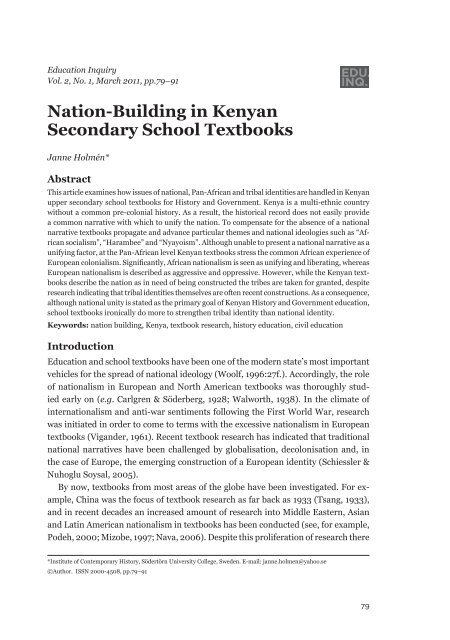Download issue - Umeå universitet
Download issue - Umeå universitet
Download issue - Umeå universitet
You also want an ePaper? Increase the reach of your titles
YUMPU automatically turns print PDFs into web optimized ePapers that Google loves.
Education Inquiry<br />
Vol. 2, No. 1, March 2011, pp.79–91<br />
EDU.<br />
INQ.<br />
Nation-Building in Kenyan<br />
Secondary School Textbooks<br />
Janne Holmén*<br />
Abstract<br />
This article examines how <strong>issue</strong>s of national, Pan-African and tribal identities are handled in Kenyan<br />
upper secondary school textbooks for History and Government. Kenya is a multi-ethnic country<br />
without a common pre-colonial history. As a result, the historical record does not easily provide<br />
a common narrative with which to unify the nation. To compensate for the absence of a national<br />
narrative textbooks propagate and advance particular themes and national ideologies such as “African<br />
socialism”, “Harambee” and “Nyayoism”. Although unable to present a national narrative as a<br />
unifying factor, at the Pan-African level Kenyan textbooks stress the common African experience of<br />
European colonialism. Significantly, African nationalism is seen as unifying and liberating, whereas<br />
European nationalism is described as aggressive and oppressive. However, while the Kenyan textbooks<br />
describe the nation as in need of being constructed the tribes are taken for granted, despite<br />
research indicating that tribal identities themselves are often recent constructions. As a consequence,<br />
although national unity is stated as the primary goal of Kenyan History and Government education,<br />
school textbooks ironically do more to strengthen tribal identity than national identity.<br />
Keywords: nation building, Kenya, textbook research, history education, civil education<br />
Introduction<br />
Education and school textbooks have been one of the modern state’s most important<br />
vehicles for the spread of national ideology (Woolf, 1996:27f.). Accordingly, the role<br />
of nationalism in European and North American textbooks was thoroughly studied<br />
early on (e.g. Carlgren & Söderberg, 1928; Walworth, 1938). In the climate of<br />
internationalism and anti-war sentiments following the First World War, research<br />
was initiated in order to come to terms with the excessive nationalism in European<br />
textbooks (Vigander, 1961). Recent textbook research has indicated that traditional<br />
national narratives have been challenged by globalisation, decolonisation and, in<br />
the case of Europe, the emerging construction of a European identity (Schiessler &<br />
Nuhoglu Soysal, 2005).<br />
By now, textbooks from most areas of the globe have been investigated. For example,<br />
China was the focus of textbook research as far back as 1933 (Tsang, 1933),<br />
and in recent decades an increased amount of research into Middle Eastern, Asian<br />
and Latin American nationalism in textbooks has been conducted (see, for example,<br />
Podeh, 2000; Mizobe, 1997; Nava, 2006). Despite this proliferation of research there<br />
*Institute of Contemporary History, Södertörn University College, Sweden. E-mail: janne.holmen@yahoo.se<br />
©Author. ISSN 2000-4508, pp.79–91<br />
79

















